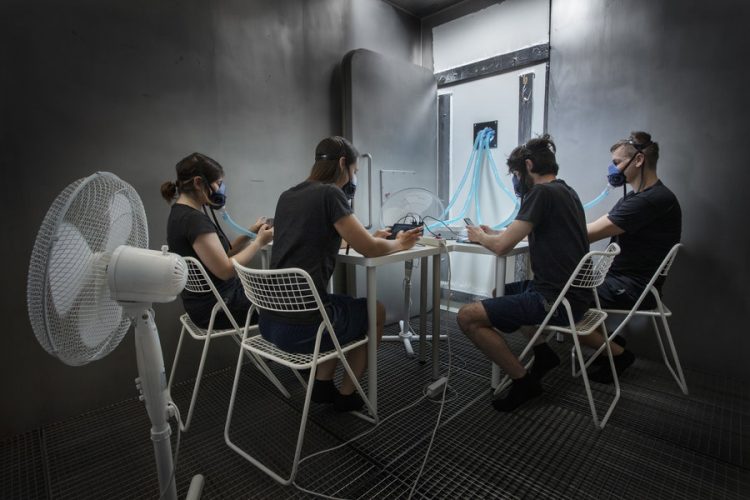Human skin is an important source of ammonia emissions

The experiments took place in a special controlled chamber located at the Technical University of Denmark. Photo: Mikal Schlosser
In many regions of the world, people now spend over 90 percent of their life in indoor environments. In our homes and offices, we are exposed to many chemicals, some of which we generate ourselves. However, these human emissions haven´t been investigated in detail and little research has been done in the past on what drives human ammonia emissions.
Scientists from Max Planck Institute for Chemistry (MPIC), the International Centre for Indoor Environment and Energy at the Technical University of Denmark, and Rutgers University of New Jersey conducted a series of indoor experiments.
The researchers found out that human skin emits much more ammonia (NH3) than previously assumed. The amounts are so high that they can neutralize the acidifying impacts of human CO2 emissions indoors.
Ammonia emissions increase significantly with rising temperature in the room and more exposed skin. The results of the experiments which were recently published in the journal “Environmental Science & Technology“ also showed that human skin is a much stronger ammonia emitter than the breath.
The experiments took place in a special controlled chamber located at the Technical University of Denmark. The study participants (men and women of different age groups) stayed in this room for several hours while air was flushed over them and measured downwind. Occasionally they had to breathe into a special mask, which made it possible to measure the chemical composition of their breath and skin separately.
Furthermore, the scientists varied the temperature, humidity and ozone levels in the chamber as well as the clothing of the study participants in order to see how the different environmental conditions affect the emissions.
Ammonia in the human body stems primarily from the bacterial breakdown of proteins within cells and the intestine. It is transported by blood to the liver where it is converted to urea and ultimately washed out in urine.
Ammonia remaining in the blood can diffuse through the skin or be emitted in sweat or breath. Research on ammonia skin emissions is tricky. One reason for that is that the molecule is very adhesive.
“As the ammonia attaches itself to walls or fabrics it can change the pH of water on the surfaces and thus neutralize the acidifying effects of CO2 that comes out of our breath. It can hence change the chemistry of surfaces in your house turning them into less acidic”, Jonathan Williams, a scientific group leader at MPIC.
“Indoor air investigation is becoming more and more important”, says Mengze Li, PhD student at MPIC and first author of the study. In the past years many measurements have been conducted on gaseous emissions of furniture, floor covering or technical devices indoors.
However, over time the materials used for the production of these objects improved and their emissions went down. Furthermore, housing became more efficient – new buildings have better insulation and less air circulation in order to preserve energy. “It is therefore essential to understand how humans affect indoor air”, adds Williams.
Through its relevance in the formation of particulate matter, NH3 plays an important role in air quality. “We usually think that outdoor air influences indoor air. But looking at our measurements we might assume that in a hot, humid, densely populated megacity human ammonia emissions indoors could actually affect the particle production in outdoor air”, adds Williams. Results from this study can be used to more accurately model indoor and inner-city outdoor NH3 concentrations and associated chemistry.
Jonathan Williams
Max Planck Institute for Chemistry, Mainz
Telephone: +49 6131 305 4500
E-Mail: jonathan.williams@mpic.de
Human Ammonia Emission Rates under Various Indoor Environmental Conditions
Mengze Li, Charles J. Weschler, Gabriel Bekö, Pawel Wargocki, Gregor Lucic, Jonathan Williams
Environmental Science and Technology. 2020, 54, 9, 5419-5428
Publication Date:April 1, 2020
https://doi.org/10.1021/acs.est.0c00094
Media Contact
More Information:
http://www.mpic.de/All latest news from the category: Life Sciences and Chemistry
Articles and reports from the Life Sciences and chemistry area deal with applied and basic research into modern biology, chemistry and human medicine.
Valuable information can be found on a range of life sciences fields including bacteriology, biochemistry, bionics, bioinformatics, biophysics, biotechnology, genetics, geobotany, human biology, marine biology, microbiology, molecular biology, cellular biology, zoology, bioinorganic chemistry, microchemistry and environmental chemistry.
Newest articles

Scientists transform blood into regenerative materials
… paving the way for personalized, blood-based, 3D-printed implants. Scientists have created a new ‘biocooperative’ material based on blood, which has shown to successfully repair bones, paving the way for…

A new experimental infection model in flies
…offers a fast and cost-effective way to test drugs. Researchers at the Germans Trias i Pujol Research Institute and Hospital have reinforced their leading role in infectious disease research by…

Material developed with novel stretching properties
KIT researchers produce metamaterial with different extension and compression properties than conventional materials. With this material, the working group headed by Professor Martin Wegener at KIT’s Institute of Applied Physics…



